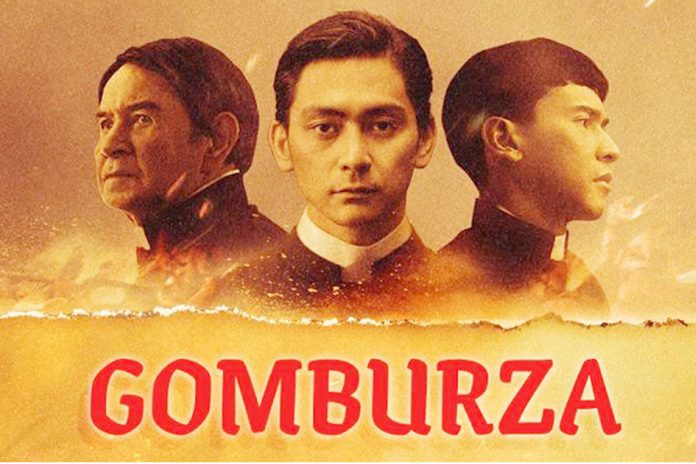As the movie ended, there was some clapping of hands, and deservedly so. Indeed, hours after I watched the film, I still feel emotional.
Let me give some reasons why Filipinos should watch this movie, GOMBURZA.
Surely, the more we know about our history, the less the danger of repeating the mistakes of the past. But let me go to some specifics.
Why should students and those in the academe watch this film?
1. Most history textbooks fail to make the connection between our national hero Jose Rizal and the three martyred priests, Jose Burgos, Mariano Gomez, and Jacinto Zamora. They fail to mention that Rizal himself acknowledged his debt to the three martyrs when he wrote, “Without 1872, there would not now be a Plaridel, a Jaena, a Sancianco… Without 1872, Rizal would now be a Jesuit and instead of writing the Noli Me Tangere, would have written the contrary. At the sight of those injustices and cruelties, though still a child, my imagination awoke, and I swore to dedicate myself to avenge one day so many victims. With this idea I have gone on studying, and this can be read in all my works and writings. God will grant me one day to fulfill my promise…” In contrast to the omission in textbooks, there is a scene in the movie where the 10-year-old Jose watched the execution. He was so moved by the injustice of it all that he was transformed from a mere observer brought by his elder brother Paciano to someone who cried for justice. Indeed, the movie traces the connection all the way to Paciano Mercado, who was a student of Burgos.
2. A superficial student of history imagines that we think of ourselves as Filipinos almost automatically. Such is far from historical reality. During much of the Spanish period, Tagalogs thought of themselves as Tagalogs, the Bisaya thought of themselves as Bisaya, etc. We did not think of ourselves as Filipinos. How and when did the national consciousness emerge? I don’t think it is possible to pinpoint a specific time. It was a gradual evolution of national consciousness. But the movie correctly points to the secularization controversy and the subsequent martyrdom of Gomburza as great contributors to the formation of our imagination as a nation. In fact, the movie is to be commended not only for its portrayal of the secularization controversy but for tracing it back to the death of Hermano Pule, an Indio who wanted to be a friar at a time when the religious orders still excluded the natives.
3. Some students may have read that the fight for Burgos was merely intra-ecclesial. Although church administration was the context of the controversy, still Burgos (and Pedro Pelaez before him) fought for the equality of all born in the Philippines. This is pointed out several times in the movie.
Why clerics, nuns, and seminarians should watch the movie
1. We should be learning much from Pelaez, Burgos, and Gomez. Pelaez and Burgos had doctoral degrees and their stars were rising. These stars could have continued to rise if they chose to be silent. But they chose to speak against the injustices done to the Filipino clergy. For them, there are issues worth fighting for, even at the expense of their standing within the clergy. Sacramental brotherhood does not mean that we should be silent when confronted with wrongdoings within the Church.
2. There are those in the Church who would use their power and influence to achieve their selfish ends. In the issue at hand, the Recollects used their influence to get the coveted parishes from the secular clergy. (Not explained in the movie, most probably for the sake of brevity, is that the Recollects had to surrender their parishes in Mindanao to the Jesuits who were returning from exile.) Ultimately, they had to accept the negative verdict of history.
3. I am not sure whether, in the judicial system then, Archbishop Gregorio Meliton Martinez, could have done much more to see to it that justice be served in the case of the three priests. But the simple no of the Archbishop to the request of Governor General Rafael Izquierdo was still prophetic. The negative answer was still a denunciation of the injustice. Izquierdo wanted the priests defrocked before the execution. According to historians, Martinez wanted to get a copy of the minutes of the trial which the Governor could not or did not want to give.
Why should Filipinos today watch this film? I am referring to Filipinos who may not be interested in church issues. Should the movie be of any interest?
Well, the Spaniards may no longer be around, but the issue of nationalism continues. There would be other countries who try to exploit us. Different epochs would demand different ways of expressing nationalism
But let me give one specific reason. As shown in the movie, the case against the three priests was trumped up and could have been laughable if the court had not prejudged the case. It was based on a perjured testimony of a state witness, Francisco Zaldua, whom the accused had never met before the court scene. He was forced to give a false testimony after being tortured.
Does this not sound familiar even today?
Fr. Ramon D. Echica is the Dean of Studies of the San Carlos Major Seminary. He obtained his doctorate in Sacred Theology from the Catholic University of Leuven (Katholieke Universiteit Leuven) in 1998.









